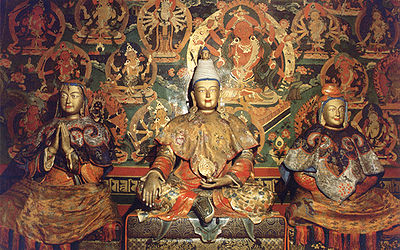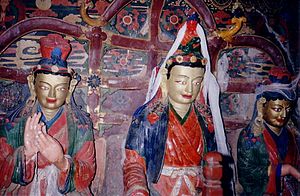- Princess Wencheng
-
Princess Wencheng (Tibetan: Mung-chang Kungco, Chinese: 文成公主, pinyin: Wénchéng Gōngzhǔ) (died 680[1]) was a niece of the powerful Emperor Taizong of China's Tang Dynasty, who left China in 640, according to records, arriving the next year in Tibet to marry the thirty-seven year old Songtsän Gampo (605?–650 CE) the thirty-third king of the Yarlung Dynasty of Tibet, in a marriage of state as part of a peace treaty along with large quantities of gold. She is popularly known in Tibet as Gyasa, or 'Chinese wife'.[2] The princess is portrayed as a Buddhist and, along with Songtsän Gampo's Nepalese wife, Bhrikuti Devi, is said to have introduced Buddhism to Tibet.[3]
The Chinese records mention receiving an envoy in 634 from Songtsän Gampo wherein the king requested (Tibetan sources say demanded)[4][5] to marry a Chinese princess and was refused. In 635/636 the Tibetan king's forces attacked and defeated the 'A zha people (Chinese: Tüyühün), who lived around Lake Koko Nor in present-day Qinghai, along an important trade route into China. After a campaign against China in 635–6 (OTA l. 607) (during which Chinese won) the Chinese emperor agreed (under threat of force, according to Tibetan histories)[4] to marry a Chinese princess to king Songtsän Gampo as part of the diplomatic settlement. As a marriage of state, the union must be considered a success as peace between China and Tibet prevailed for the remainder of Songtsen Gampo's reign.
 Wencheng's and co-wife Bhrikuti's legacy—Jokhang Temple in Tibet—founded to house statues of the Buddha which each bride brought with her dowry.
Wencheng's and co-wife Bhrikuti's legacy—Jokhang Temple in Tibet—founded to house statues of the Buddha which each bride brought with her dowry.
Contents
The wedding's cultural importance
Myths about Songtsän Gampo and his Chinese bride Wencheng that appeared during the Middle Ages transformed Songtsän Gampo into a cultural hero for Tibetans, based on his marriages [1]. It is widely believed that his state marriages to Nepalese princess Bhrikuti and Chinese princess Wencheng brought Buddhism to Tibet, and further, that their complicated relationship as co-wives led to the construction of the Jokang Temple, whereupon the city of Lhasa. These stories are included in such medieval romances as the Mani-bka'-'bum, and historiographies such as the Rgyal-rabs Gsal-ba'i Me-long.
Chinese sources credit Wencheng with bringing Chinese culture to Tibet, but this is not corroborated by Tibetan sources.[6]
Changzhug monastery in Nêdong is also connected with Wencheng: a tangka embroidered by Wencheng is kept in one of its chapels.
 Songtsen Gampo (centre) Princess Wencheng (right) and Bhrikuti Devi of Nepal (left)
Songtsen Gampo (centre) Princess Wencheng (right) and Bhrikuti Devi of Nepal (left)
External links
- History of Jokang Temple, built by Songtsän Gampo.
Footnotes
- ^ Zizhi Tongjian, vol. 202. (Chinese)
- ^ Dowman 1988, p. 41
- ^ Laird 2006, pg. 35
- ^ a b Powers 2004, pp. 168-9
- ^ "Acme of Obscenity". http://www.tibetwrites.org/?Acme-of-Obscenity. Retrieved 2010-03-28.
- ^ Powers 2004, pp. 30-38
References and Further Reading
- Jiawei Wang, Nimajianzan (1997), The historical status of China's Tibet
- Beckwith, Christopher I (1987). The Tibetan Empire in Central Asia. Princeton: Princeton University Press.
- Dowman, Keith. The Power-places of Central Tibet: The Pilgrim's Guide (1988) Routledge & Kegan Paul, London and New York. ISBN 0-7102-1370-0
- Laird, Thomas. The Story of Tibet: Conversations with the Dalai Lama (2006) Grove Press, New York. ISBN 978-0-8021-1827-1
- Powers, John. History as Propaganda: Tibetan Exiles versus the People's Republic of China (2004) Oxford University Press. ISBN 978-0-19-517426-7
- Richardson, Hugh E. (1965). "How Old was Srong Brtsan Sgampo" Bulletin of Tibetology 2.1. pp 5-8.
- Richardson, Hugh E. (1997). "Mun Sheng Kong Co and Kim Sheng Kong Co: Two Chinese Princesses in Tibet." The Tibet Journal. Vol. XXII, No. 1. Spring 1997, pp. 3-11.
Categories:- 7th-century births
- 680 deaths
- Tibetan people
- History of Tibet
- Tang Dynasty princesses
- Tibetan empresses
Wikimedia Foundation. 2010.

